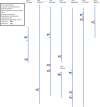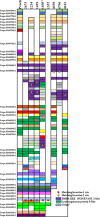Defining the 'HoneySweet' insertion event utilizing NextGen sequencing and a de novo genome assembly of plum (Prunus domestica)
- PMID: 33384410
- PMCID: PMC7775438
- DOI: 10.1038/s41438-020-00438-2
Defining the 'HoneySweet' insertion event utilizing NextGen sequencing and a de novo genome assembly of plum (Prunus domestica)
Abstract
'HoneySweet' plum (Prunus domestica) is resistant to Plum pox potyvirus, through an RNAi-triggered mechanism. Determining the precise nature of the transgene insertion event has been complicated due to the hexaploid genome of plum. DNA blots previously indicated an unintended hairpin arrangement of the Plum pox potyvirus coat protein gene as well as a multicopy insertion event. To confirm the transgene arrangement of the insertion event, 'HoneySweet' DNA was subjected to whole genome sequencing using Illumina short-read technology. Results indicated two different insertion events, one containing seven partial copies flanked by putative plum DNA sequence and a second with the predicted inverted repeat of the coat protein gene driven by a double 35S promoter on each side, flanked by plum DNA. To determine the locations of the two transgene insertions, a phased plum genome assembly was developed from the commercial plum 'Improved French'. A subset of the scaffolds (2447) that were >10 kb in length and representing, >95% of the genome were annotated and used for alignment against the 'HoneySweet' transgene reads. Four of eight matching scaffolds spanned both insertion sites ranging from 157,704 to 654,883 bp apart, however we were unable to identify which scaffold(s) represented the actual location of the insertion sites due to potential sequence differences between the two plum cultivars. Regardless, there was no evidence of any gene(s) being interrupted as a result of the insertions. Furthermore, RNA-seq data verified that the insertions created no new transcriptional units and no dramatic expression changes of neighboring genes.
Conflict of interest statement
The authors declare that they have no conflict of interest.
Figures



References
-
- Scorza R, et al. ‘HoneySweet’(C5), the first genetically engineered plum pox virus–resistanT Plum (Prunus domestica L.) cultivar. HortScience. 2016;51:601–603. doi: 10.21273/HORTSCI.51.5.601. - DOI
-
- Scorza R, et al. Hairpin Plum pox virus coat protein (hpPPV-CP) structure in ‘HoneySweet’C5 plum provides PPV resistance when genetically engineered into plum (Prunus domestica) seedlings. Jul.-K.ühn-Arch. 2010;427:141.
Grants and funding
LinkOut - more resources
Full Text Sources
Other Literature Sources

